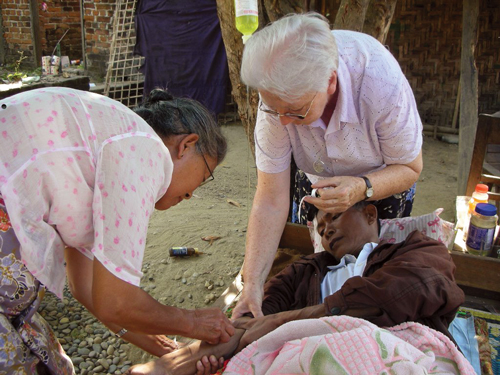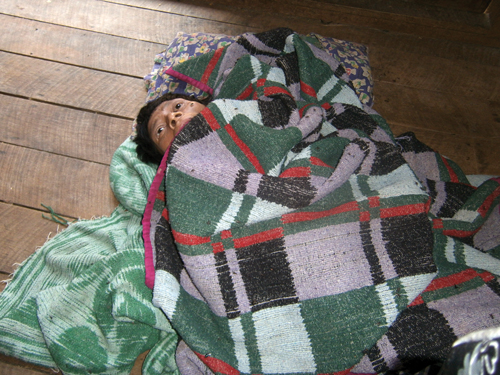Death is stark for the poor
By Sr Mary Dillon SSC
The author is a Columban Sister from Ireland. She has been in the Diocese of Myitkyina, Kachin State, Myanmar (Burma) since 2002. She has developed a home care health program for people with HIV/AIDS and established a respite house, Home of Hope, to enable people from distant places to avail of medical care. Here she reflects on her experience of burials in Myanmar.
I was shocked when I read about the costs of funerals in Ireland. An exorbitant sum was quoted, several thousand euro (€1.00 = PHP58.00), even for a simple, ‘no frills’ burial. Many people it seems spend a long time paying off the debt. Others talked of the cost of a grave, the advantages of cremation, the necessity of a wake or a meal after the burial, and so on. It was all very sobering.

What a contrast to my experience of burials in Myitkyina, Myanmar! For the past nine years here in Myanmar I have been working with the very poor.
In the last year we buried approximately 48 patients from the 30-bed Home of Hope where I am. Most of these, men and women, died of AIDS. The majority had no one to mourn them, no family to grieve at their going.
Some left small children behind them with no one to care for them. All of them had sad stories, sometimes almost unbearable, as they struggled with the disease, especially in their final weeks.
Six years ago we built this Home of Hope, with the help of many benefactors in different countries. Even if I say it myself, it is a lovely place, simple but well-structured, a light-filled space.
We wanted to give the best to the poor who suffer so much in their lives, struggling to eke an existence in a country that is so rich in natural resources, resources to which they have no access.

If the sick come in time, even though they have AIDS, they make a good recovery with the help of retro-viral drugs, good, nourishing food and care. Never fully healed, they are nevertheless able to go back to their families with new hope. Many of them live hundreds of kilometers from the Home of Hope so it is a great day when they set out on their journey back.
Over the years, because of the many deaths here, I have learnt a lot about the local burial customs here. First of all, I always have a good supply of wood at hand. When someone dies I tell our handyman, Bwak Naw; he looks at the body, and quickly fashions a simple coffin from plywood boards. The body is then brought in a three-wheeled pedicab (trisikad) to the temple.
After the temple prayers, the coffin is brought to the graveside, accompanied by the relatives (if any are present) and some of the patients. I always go with them. The group are met by the graveyard master before whom the coffin is swung gently to signify submission of the dead person to him. It is then placed on bamboo poles over the grave and the graveyard master walks around it, bending to make chopping movements signifying the severance of the dead from all earthly ties.
The relatives may then sweep a towel over the corpse to gather his/her spirit to take back with them to the home place. When the body is put in the grave the mourners talk to it, telling their relative that he/she is now in a good place with lovely scenery, beautiful trees, rivers and lakes. The earth is then put in. A cross with the name and date of death is placed over every grave, regardless of the religion of the dead person.
After the burial all come back to the Home where, after washing our hands, we partake of coffee and bread. Then the relatives, if any, go back home, often a long journey.
There have been some heartbreaking cases where the only relative is a child. Before I left we had a 38-year-old mother of five children who made a nine-hour train journey to
reach us. Her husband had already died from AIDS. Her eldest daughter, 13-year-old Bwak Ja, traveled with her, leaving the other children at home. Not one of them had ever been to school. The woman was seriously ill and sadly she died after surgery.Alone now, her destitute daughter stood in the Temple as the monks chanted. She stood at the graveside as her mother was put into the grave and wept as the final shovel of earth fell. She had no one at all, no relative, no friend at this terrible time. We took her back to the Home where she stayed for a few days and then I helped her to face her long journey home to join her four orphaned siblings. What future does this child face?
Death is very stark for the poor here in Myitkyina. They have little time to mourn; they must return straight away to eke out a living for their family. You feel their pain, you know their grief, but you know they will get on with life, however wretched their situation.
Survival is the goal. How much does a funeral cost here in Myitkyina? About €100 (PHP5,800). Nobody saves for their burial; somehow it all works out.
